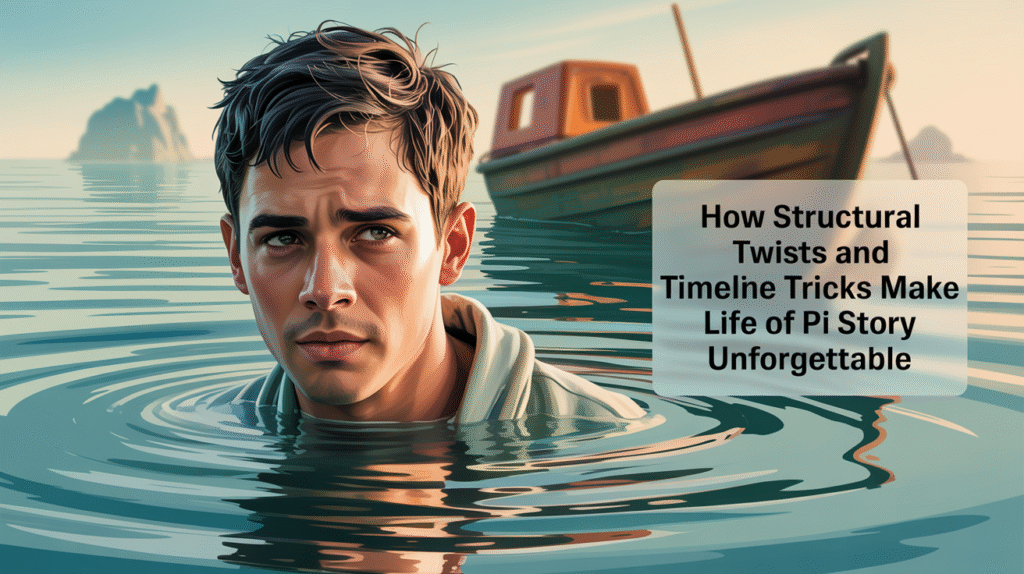Life of Pi captivates readers not just through its story, but through how that story is told. Yann Martel uses structural twists and timeline manipulation to challenge perceptions, raise philosophical questions, and enhance narrative impact.

Here’s how these literary tactics work—and why they make the novel a masterclass in storytelling.
The Framed Narrative Sets Up a Twist From the Start
The novel opens with a writer character—an altered version of Martel himself—who introduces the story as a secondhand account. This framing device hints early on that the story may not be as straightforward as it seems.
Built-In Ambiguity
- The frame suggests that what follows has been filtered, interpreted, and possibly romanticized.
- It plants a seed of doubt in the reader’s mind before Pi’s story even begins.
Adds Realism and Distance
- By presenting the narrative as a “found story,” Martel adds a documentary feel.
- The frame separates the reader from the events just enough to question them critically.
Non-Linear Storytelling Enhances Suspense
Though the bulk of the novel follows Pi’s ordeal at sea, Martel inserts flashbacks and future hints throughout the narrative.
Time Jumps
- Moments from Pi’s life after the shipwreck—like his family life in Canada—are scattered throughout.
- These scenes confirm his survival but leave questions about what he endured.
Flashbacks to Childhood
- Early chapters about Pi’s youth, family, and religious interests don’t follow a strict timeline.
- These backstories enrich the main narrative and foreshadow Pi’s inner strength and moral complexity.
The Two-Story Reveal Rewrites the Entire Book
Perhaps the most striking structural twist is the reveal at the end that Pi has two versions of the story—one with animals, one with humans.
A Literal Twist in Perspective
- The animal story is suddenly challenged by a far darker, human-based version.
- This changes how readers interpret every previous event—from Richard Parker’s behavior to the symbolism of the floating island.
Philosophical Impact
- The twist isn’t just about plot—it’s about the nature of truth and the role of belief.
- Martel leaves the reader with a choice: believe the harsh reality or the meaningful fiction.
Pi as an Adult Narrows the Emotional Gap
Throughout the book, we know that Pi survives—he’s narrating the story as an adult. This foreknowledge doesn’t reduce tension; it shifts focus from outcome to interpretation.
Survival Is a Given, Not the Mystery
- The real suspense is emotional and spiritual, not physical.
- Readers are drawn to understand how the trauma shaped Pi and what it all means.
Adds Reflective Wisdom
- As an adult, Pi comments on his past choices with philosophical insight.
- This dual viewpoint creates a complex emotional tone—part trauma, part transcendence.
Timeline Tricks Deepen Themes of Memory and Belief
By bending time and narrative sequence, Martel mirrors the book’s broader themes: memory, faith, and the blurry line between truth and fiction.
Subjective Time
- The ocean scenes blur time as Pi drifts—days blend together, reflecting isolation and confusion.
- This use of time distortion emphasizes Pi’s psychological state.
Retrospective Structure
- Because Pi tells the story after surviving it, everything is filtered through memory.
- His selective recollection raises questions about accuracy and reliability.
The Structure Engages Readers in Active Meaning-Making
Martel’s nonlinear and twist-laden structure doesn’t just entertain—it demands that readers participate in building the story’s meaning.
Reader’s Choice
- The ending invites readers to pick which story they believe.
- This open-ended approach forces a personal response—one that mirrors religious faith or doubt.
Literary Engagement
- By layering timelines, voices, and revelations, Martel creates a narrative puzzle.
- Readers aren’t passive—they must assemble meaning as the story unfolds.
FAQ: Structural Twists and Timeline Tricks in Life of Pi
Here are some questions and answers about the structure and time-related storytelling techniques in Life of Pi.
What is the biggest twist in Life of Pi?
The major twist comes when Pi offers an alternate version of the story—without animals—at the end. This challenges everything the reader believed and reframes the entire narrative.
Why is the timeline in Life of Pi nonlinear?
The timeline moves between Pi’s childhood, his time at sea, and his life afterward. This structure mirrors memory and reflects the novel’s themes of perception, belief, and trauma.
What is the purpose of the framed narrative?
The frame adds credibility and sets up the novel as a story being retold. It distances the reader just enough to allow for ambiguity and reflection.
Does the ending change the entire story?
Yes. The revelation that Pi may have fabricated the animal version forces readers to reinterpret earlier events and consider the role of storytelling in coping with trauma.
How does time affect the emotional tone of the novel?
Time is used to show psychological isolation, spiritual reflection, and the breakdown of linear reality. It shapes the novel’s dreamlike, philosophical tone.
By using structural twists and a flexible timeline, Life of Pi transforms a survival tale into a rich, multi-layered meditation on truth, trauma, and belief. Its unconventional structure is not just stylistic—it’s the key to its power.
